Gear Peugeot Boxer 2012 Owner's Manual
[x] Cancel search | Manufacturer: PEUGEOT, Model Year: 2012, Model line: Boxer, Model: Peugeot Boxer 2012Pages: 184, PDF Size: 4.88 MB
Page 4 of 184
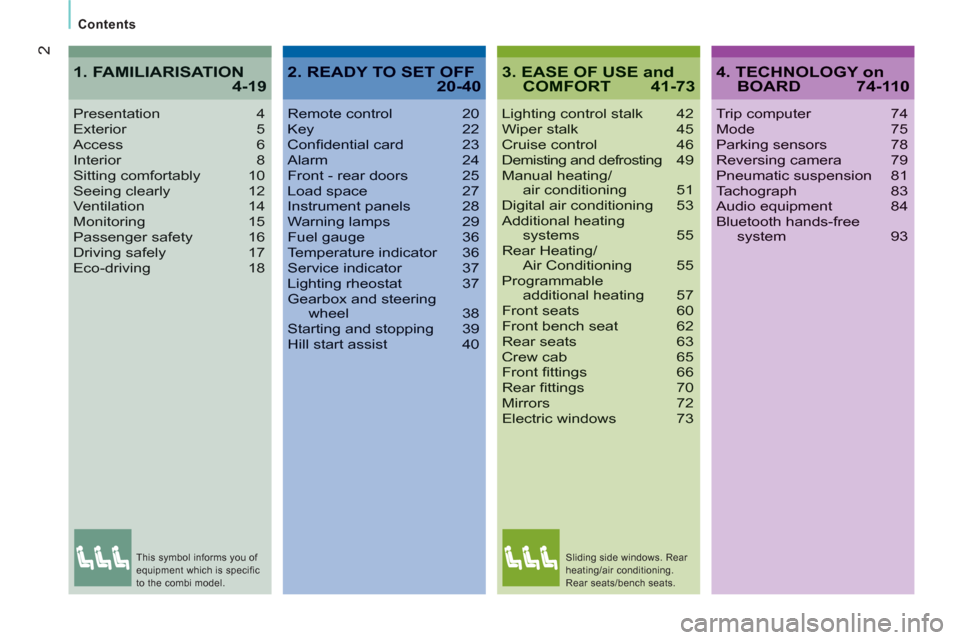
2
Contents
3. EASE OF USE andCOMFORT 41-73
Lighting control stalk 42Wiper stalk 45Cruise control 46Demisting and defrosting49Manual heating/air conditioning 51Digital air conditioning 53Additional heating systems 55Rear Heating/Air Conditioning 55Programmableadditional heating 57Front seats 60Front bench seat 62Rear seats 63Crew cab 65Front fi ttings 66Rear fi ttings 70Mirrors 72Electric windows 73
Presentation4Exterior 5Access6Interior 8Sitting comfortably 10Seeing clearly 12Ventilation 14Monitoring 15Passenger safety 16Driving safely 17Eco-driving 18
1. FAMILIARISATION4-194. TECHNOLOGY onBOARD 74-110
Trip computer 74Mode 75Parking sensors 78Reversing camera 79Pneumatic suspension 81Tachograph 83Audio equipment 84Bluetooth hands-free system 93
2. READY TO SET OFF20-40
Remote control 20Key 22Confi dential card 23Alarm 24Front - rear doors 25Load space 27Instrument panels 28Warning lamps 29Fuel gauge 36Temperature indicator 36Service indicator 37Lighting rheostat 37Gearbox and steeringwheel 38Starting and stopping 39Hill start assist 40
This symbol informs you of
equipment which is specific
to the combi model. Sliding side windows. Rear
heating/air conditioning.
Rear seats/bench seats.
Page 7 of 184

4
34
2
1
FAMILIARISATION
5
Familiarisation
Reversing camera
This system is activated automatically
when reverse gear is engaged, with a
visual return on a screen that takes the
place of the interior rear view mirror.
79
78
43
EXTERIOR
"Guide-me-home" welcome
lighting
After switching off the ignition, when you
leave the vehicle, the front lamps remain
on for a short period.
Opening the rear doors to 180°
Once the vehicle has been unlocked, the
rear doors can be opened to 180° to make
unloading/loading operations easier.
Rear parking sensors
This system warns you if an obstacle is
detected behind the vehicle when reverse
gear is engaged.
26
Page 11 of 184
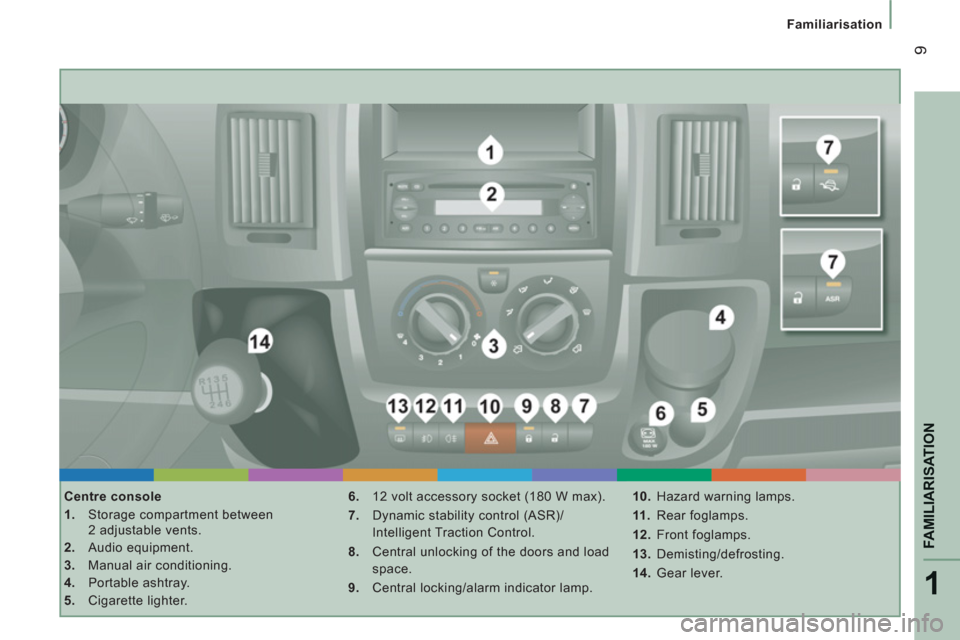
1
FAMILIARISATION
9
Familiarisation
Centre console
1.
Storage compartment between
2 adjustable vents.
2.
Audio equipment.
3.
Manual air conditioning.
4.
Portable ashtray.
5.
Cigarette lighter.
6.
12 volt accessory socket (180 W max).
7.
Dynamic stability control (ASR)/
Intelligent Traction Control.
8.
Central unlocking of the doors and load
space.
9.
Central locking/alarm indicator lamp.
10.
Hazard warning lamps.
11 .
Rear foglamps.
12.
Front foglamps.
13.
Demisting/defrosting.
14.
Gear lever.
Page 17 of 184
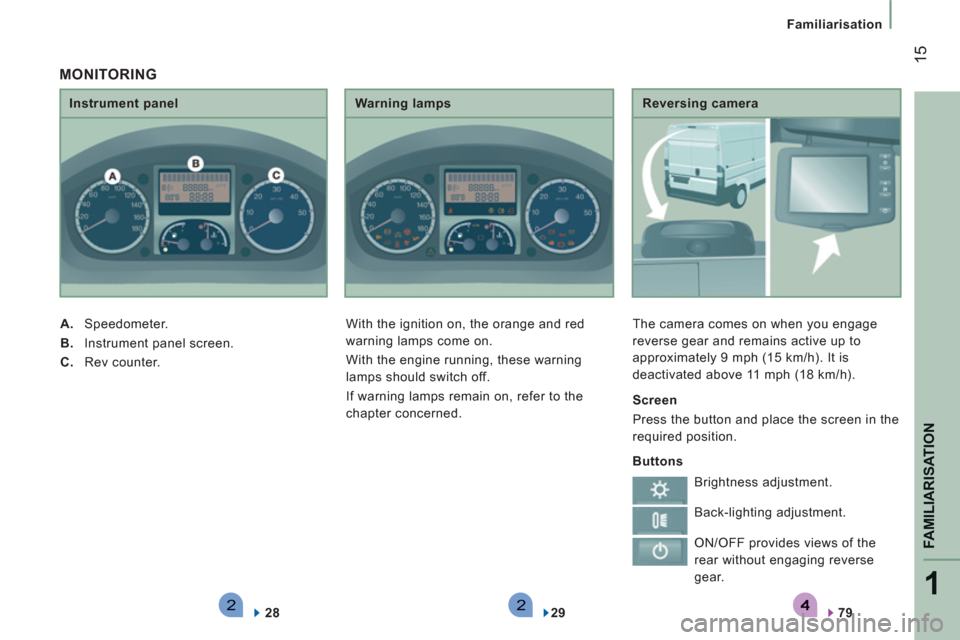
221
FAMILIARISATION
15
Familiarisation
Reversing camera
The camera comes on when you engage
reverse gear and remains active up to
approximately 9 mph (15 km/h). It is
deactivated above 11 mph (18 km/h).
79
Instrument panel
A.
Speedometer.
B.
Instrument panel screen.
C.
Rev counter.
28
Warning lamps
With the ignition on, the orange and red
warning lamps come on.
With the engine running, these warning
lamps should switch off.
If warning lamps remain on, refer to the
chapter concerned.
29
MONITORING
Buttons
Brightness adjustment.
Screen
Press the button and place the screen in the
required position.
Back-lighting adjustment.
ON/OFF provides views of the
rear without engaging reverse
gear.
Page 20 of 184

18
ECO-DRIVING
Optimise the use of your gearbox
With a manual gearbox, move off gently,
change up without waiting and drive by
changing up quite soon. If your vehicle has
the system, the gear shift indicator invites
you to change up; it is displayed in the
instrument panel, follow its instructions.
With an automatic or electronic gearbox,
stay in Drive "D"
or Auto "A"
, according to
the type of gearbox, without pressing the
accelerator pedal heavily or suddenly.
Drive smoothly
Maintain a safe distance between vehicles,
use engine braking rather than the
brake pedal, and press the accelerator
progressively. These practices contribute
towards a reduction in fuel consumption
and CO
2 emissions and also helps reduce
the background traffic noise.
If your vehicle has cruise control, make
use of the system at speeds above 25 mph
(40 km/h) when the traffic is flowing well.
Control the use of your electricalequipment
Before moving off, if the passenger
compartment is too warm, ventilate it by
opening the windows and air vents before
using the air conditioning.
Above 30 mph (50 km/h), close the windows
and leave the air vents open.
Remember to make use of equipment
that can help keep the temperature in the
passenger compartment down (sun roof and
window blinds...).
Switch off the air conditioning, unless it has
automatic digital regulation, as soon as the
desired temperature is attained.
Switch off the demisting and defrosting
controls, if not automatic.
Switch off the heated seat as soon as
possible.
Switch off the headlamps and front foglamps
when the level of light does not require their
use.
Avoid running the engine before moving
off, particularly in winter; your vehicle will
warm up much faster while driving.
As a passenger, if you avoid connecting
your multimedia devices (film, music,
video game...), you will contribute towards
limiting the consumption of electrical
energy, and so of fuel.
Disconnect your portable devices before
leaving the vehicle.
Eco-driving is a range of everyday practices that allow the motorist to optimise their fuel consumption and CO
2 emissions.
Page 40 of 184
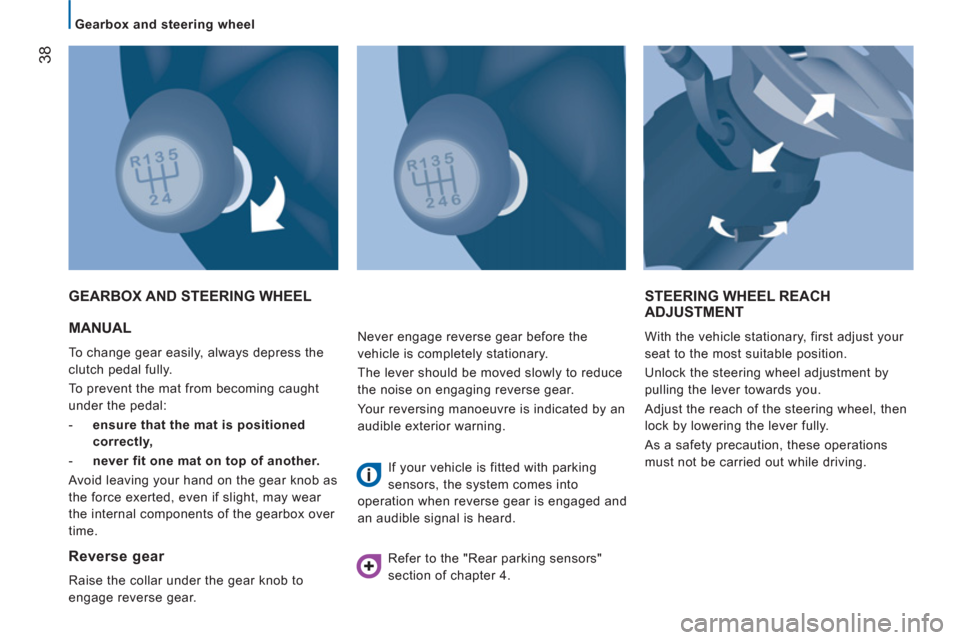
38
Gearbox and steering wheel
MANUAL
To change gear easily, always depress the
clutch pedal fully.
To prevent the mat from becoming caught
under the pedal:
- ensure that the mat is positioned
correctly,
- never fit one mat on top of another.
Avoid leaving your hand on the gear knob as
the force exerted, even if slight, may wear
the internal components of the gearbox over
time.
GEARBOX AND STEERING WHEEL STEERING WHEEL REACH
ADJUSTMENT
With the vehicle stationary, first adjust your
seat to the most suitable position.
Unlock the steering wheel adjustment by
pulling the lever towards you.
Adjust the reach of the steering wheel, then
lock by lowering the lever fully.
As a safety precaution, these operations
must not be carried out while driving.
Reverse gear
Raise the collar under the gear knob to
engage reverse gear. Never engage reverse gear before the
vehicle is completely stationary.
The lever should be moved slowly to reduce
the noise on engaging reverse gear.
Your reversing manoeuvre is indicated by an
audible exterior warning.
If your vehicle is fitted with parking
sensors, the system comes into
operation when reverse gear is engaged and
an audible signal is heard.
Refer to the "Rear parking sensors"
section of chapter 4.
Page 41 of 184
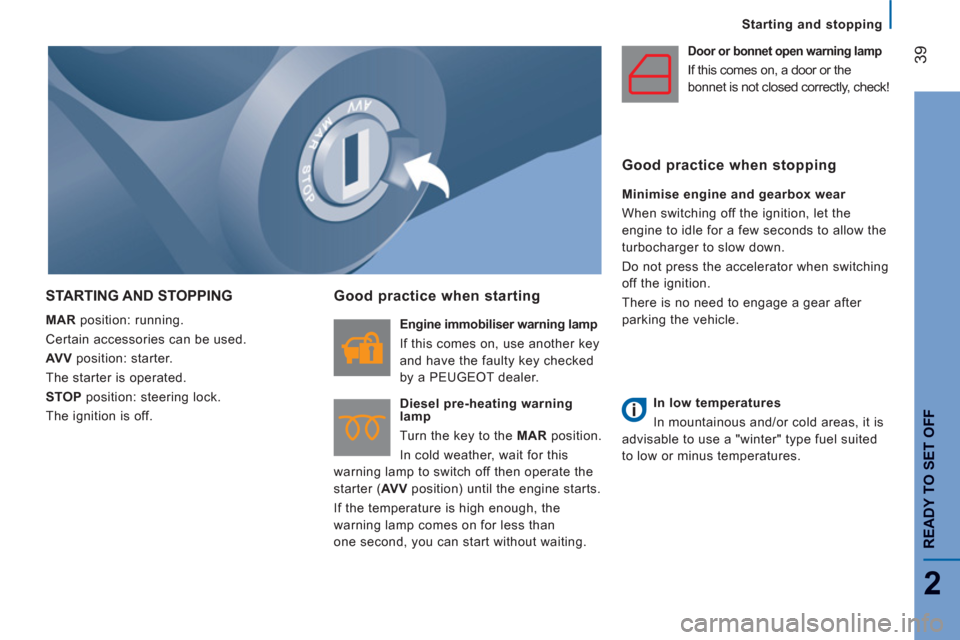
39
2
READY TO SET OFF
Starting and stopping
STARTING AND STOPPING
MAR
position: running.
Certain accessories can be used.
AV V
position: starter.
The starter is operated.
STOP
position: steering lock.
The ignition is off.
Good practice when starting
Engine immobiliser warning lamp
If this comes on, use another key
and have the faulty key checked
by a PEUGEOT dealer.
Diesel pre-heating warning
lamp
Turn the key to the MAR
position.
In cold weather, wait for this
warning lamp to switch off then operate the
starter ( AV V
position) until the engine starts.
If the temperature is high enough, the
warning lamp comes on for less than
one second, you can start without waiting.
Door or bonnet open warning lamp
If this comes on, a door or the
bonnet is not closed correctly, check!
Good practice when stopping
Minimise engine and gearbox wear
When switching off the ignition, let the
engine to idle for a few seconds to allow the
turbocharger to slow down.
Do not press the accelerator when switching
off the ignition.
There is no need to engage a gear after
parking the vehicle.
In low temperatures
In mountainous and/or cold areas, it is
advisable to use a "winter" type fuel suited
to low or minus temperatures.
Page 42 of 184
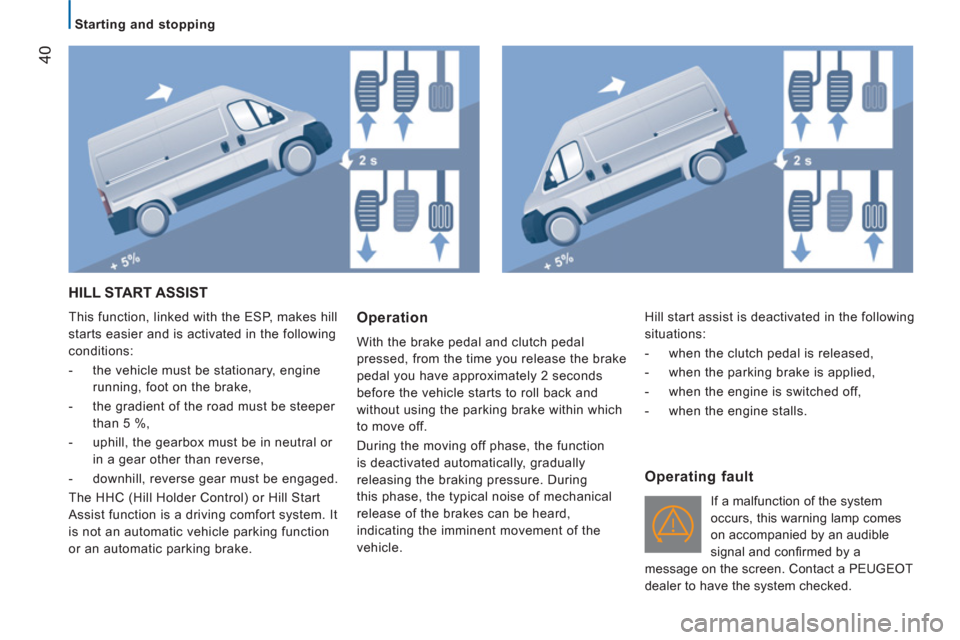
40
Starting and stopping
HILL START ASSIST
This function, linked with the ESP, makes hill
starts easier and is activated in the following
conditions:
- the vehicle must be stationary, engine
running, foot on the brake,
- the gradient of the road must be steeper
than 5 %,
- uphill, the gearbox must be in neutral or
in a gear other than reverse,
- downhill, reverse gear must be engaged.
The HHC (Hill Holder Control) or Hill Start
Assist function is a driving comfort system. It
is not an automatic vehicle parking function
or an automatic parking brake. Operation
With the brake pedal and clutch pedal
pressed, from the time you release the brake
pedal you have approximately 2 seconds
before the vehicle starts to roll back and
without using the parking brake within which
to move off.
During the moving off phase, the function
is deactivated automatically, gradually
releasing the braking pressure. During
this phase, the typical noise of mechanical
release of the brakes can be heard,
indicating the imminent movement of the
vehicle.
Operating fault
If a malfunction of the system
occurs, this warning lamp comes
on accompanied by an audible
signal and confi rmed by a
message on the screen. Contact a PEUGEOT
dealer to have the system checked. Hill start assist is deactivated in the following
situations:
- when the clutch pedal is released,
- when the parking brake is applied,
- when the engine is switched off,
- when the engine stalls.
Page 48 of 184
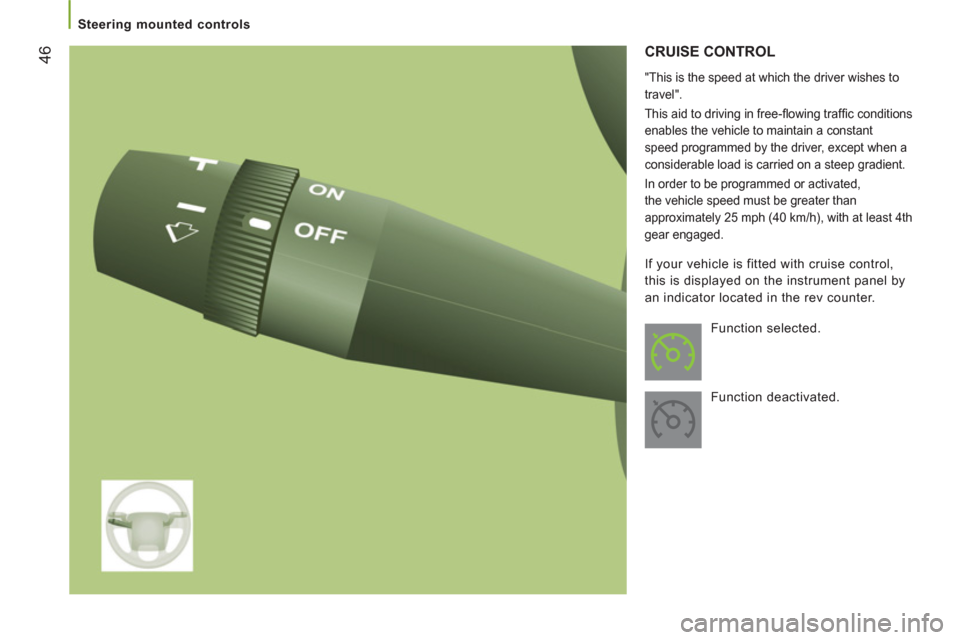
46
Steering mounted controls
CRUISE CONTROL
"This is the speed at which the driver wishes to
travel".
This aid to driving in free-fl owing traffi c conditions
enables the vehicle to maintain a constant
speed programmed by the driver, except when a
considerable load is carried on a steep gradient.
In order to be programmed or activated,
the vehicle speed must be greater than
approximately 25 mph (40 km/h), with at least 4th
gear engaged.
Function selected.
Function deactivated. If your vehicle is fitted with cruise control,
this is displayed on the instrument panel by
an indicator located in the rev counter.
Page 49 of 184
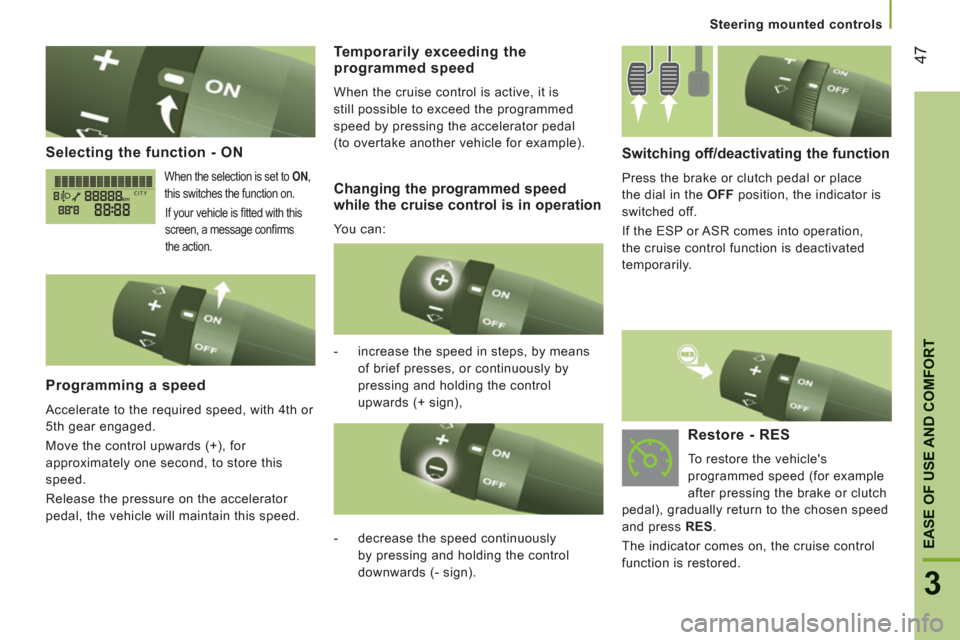
47
3
EASE OF USE AND COMFOR
T
Steering mounted controls
Selecting the function - ON
When the selection is set to ON
,
this switches the function on.
If your vehicle is fi tted with this
screen, a message confi rms
the action.
Programming a speed
Accelerate to the required speed, with 4th or
5th gear engaged.
Move the control upwards (+), for
approximately one second, to store this
speed.
Release the pressure on the accelerator
pedal, the vehicle will maintain this speed.
Switching off/deactivating the function
Press the brake or clutch pedal or place
the dial in the OFF
position, the indicator is
switched off.
If the ESP or ASR comes into operation,
the cruise control function is deactivated
temporarily.
- increase the speed in steps, by means
of brief presses, or continuously by
pressing and holding the control
upwards (+ sign),
Temporarily exceeding theprogrammed speed
When the cruise control is active, it is
still possible to exceed the programmed
speed by pressing the accelerator pedal
(to overtake another vehicle for example).
- decrease the speed continuously
by pressing and holding the control
downwards (- sign).
Restore - RES
To restore the vehicle's
programmed speed (for example
after pressing the brake or clutch
pedal), gradually return to the chosen speed
and press RES
.
The indicator comes on, the cruise control
function is restored.
Changing the programmed speed
while the cruise control is in operation
You can: